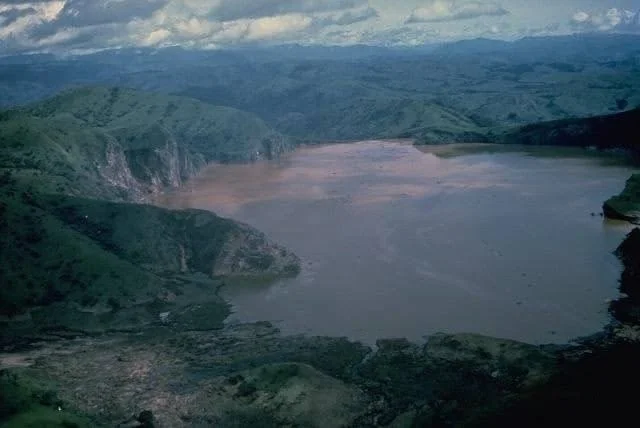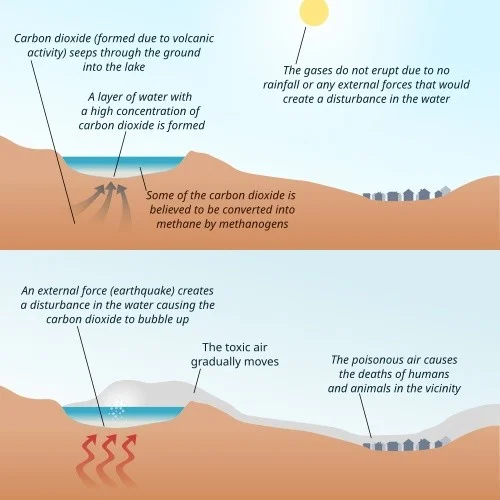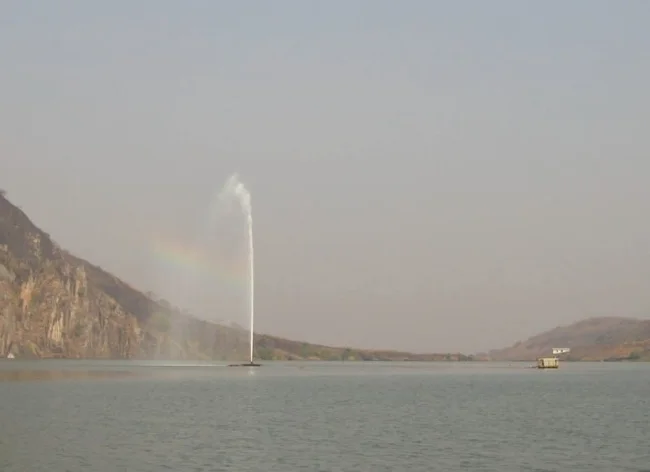Lakes with a deadly "surprise". Tragedy on Nyos (5 photos)
The purest water in the middle of rocky peaks, so transparent that in calm weather it seems as if it is not there at all. This is how people usually imagine mountain lakes. But this is just a stereotype imposed by modern media. Beautiful photos of mountain resorts are to blame for this, and you can easily find hundreds of such pictures. But, as often happens, reality is very different from what the imagination paints. 
Lake Nyos, photo of 1986
This story is about a lake in the mountains that caused the death of hundreds of people. What had been hidden for years under the seemingly clear surface of the water, one day came to light.
Lake Nyos is located in the Republic of Cameroon. It is located in the Oku volcanic massif at an altitude of 1091 meters above sea level. According to scientists, the lake is very young, having formed as a result of hydrothermal processes about four centuries ago. It was formed in a maar - a flat-bottomed crater of a volcanic explosion. Similar in origin and general structure is Lake Manoun, located to the southeast, about 95 kilometers away.
Geological processes in this region are still ongoing. Small earthquakes and periodic ash emissions from stratovolcanoes are common. However, the expression "living like on a volcano" did not appear in vain. And this was fully felt by local residents.
On August 15, 1984, a so-called limnological catastrophe occurred at Lake Manun. It is worth making a digression here and explaining what it is. Usually, a natural disaster is called a storm, hurricane, tsunami, and so on. However, the gas that was hidden under the water of the seemingly serene lake can also be dangerous. A limnological catastrophe is the release of a large volume of dissolved carbon dioxide from an open body of water. Being heavier than air, the gas accumulates in the lowlands, where houses and animal pastures are usually located. It can remain there for many hours, which means the likely death of all living creatures. This is exactly what happened at Lake Manun. Its surroundings were relatively sparsely populated, 37 people and an unknown number of livestock died. At the same time, opinions were expressed that something similar could happen at Lake Nyos.
However, no action was taken on this matter, and this had consequences. 
Lake Nyos eight days after the limnological catastrophe
On August 21, 1986, a similar release occurred on Lake Nyos. According to experts, the gas release continued for more than two hours. From 100 to 300 thousand tons of carbon dioxide entered the atmosphere. The heavy gas, rapidly leaving the lake basin, began to spread along the mountain slope in two powerful streams stretching for 25 kilometers. It killed all living things along its path. Eyewitnesses described how a hundred-meter water column rose in the center of the lake. It created a wave more than 20 meters high, which, having reached the shore, knocked down the trees standing there. The water of the lake turned red due to heavy iron compounds rising from the bottom.
But the main damage of the limnological catastrophe was caused to the settlements located in the lowlands at the foot of the mountains, where the gas streams rushed. Only confirmed victims number at least 1,700 people and about 3,500 farm animals. Witnesses also said that the air was filled with a piercing smell of rotten eggs, many survivors had a strong cough, as well as a burning sensation in the eyes, nose and mouth. Because of this, it was initially believed that the cause of the poisoning was hydrogen sulfide. 
Scheme of the limnological catastrophe on Lake Nyos
Only the catastrophe on Lake Nyos gave impetus to the beginning of a thorough study of what happened. However, the cause of the incident has not been established. The most likely versions include a volcanic eruption at the bottom of the lake or a small earthquake, which could have provoked the release of gas to the surface.
A number of measures have been taken to prevent similar catastrophes in the future. Pipes for degassing were installed on Lake Nyos. The first of them was put into operation in 2001, and two more were installed in 2011. Similar measures, although on a smaller scale, are also being carried out at Lake Manun. 
Degassing at Lake Nyos, photo from 2006
Despite the rarity and uniqueness of the incident, we should not discount the possibility of a repeat of the limnological catastrophe in other regions of the planet where there are massive gas deposits under water. According to scientists, these are the lakes near Mammoth Mountain in the United States, Lake Mashu in Japan, several volcanic lakes in the Eifel region of Germany, Lake Pavin in France, as well as some areas of the Black Sea. Today, Lake Kivu in Africa, on the border between Rwanda and the Democratic Republic of the Congo, is considered the most dangerous in terms of the likelihood of a similar incident. Methane reserves under the lake are estimated at 55 billion cubic meters. Up to two million people living on the shores of Kivu could become potential victims of a gas leak.
Limnological catastrophes are extremely rare phenomena, but their possibility should not be discounted. Humanity continues to learn about its planet and the dangers it may hide.. 
The material was prepared by the volunteer editorial staff of "World of Ships"






















